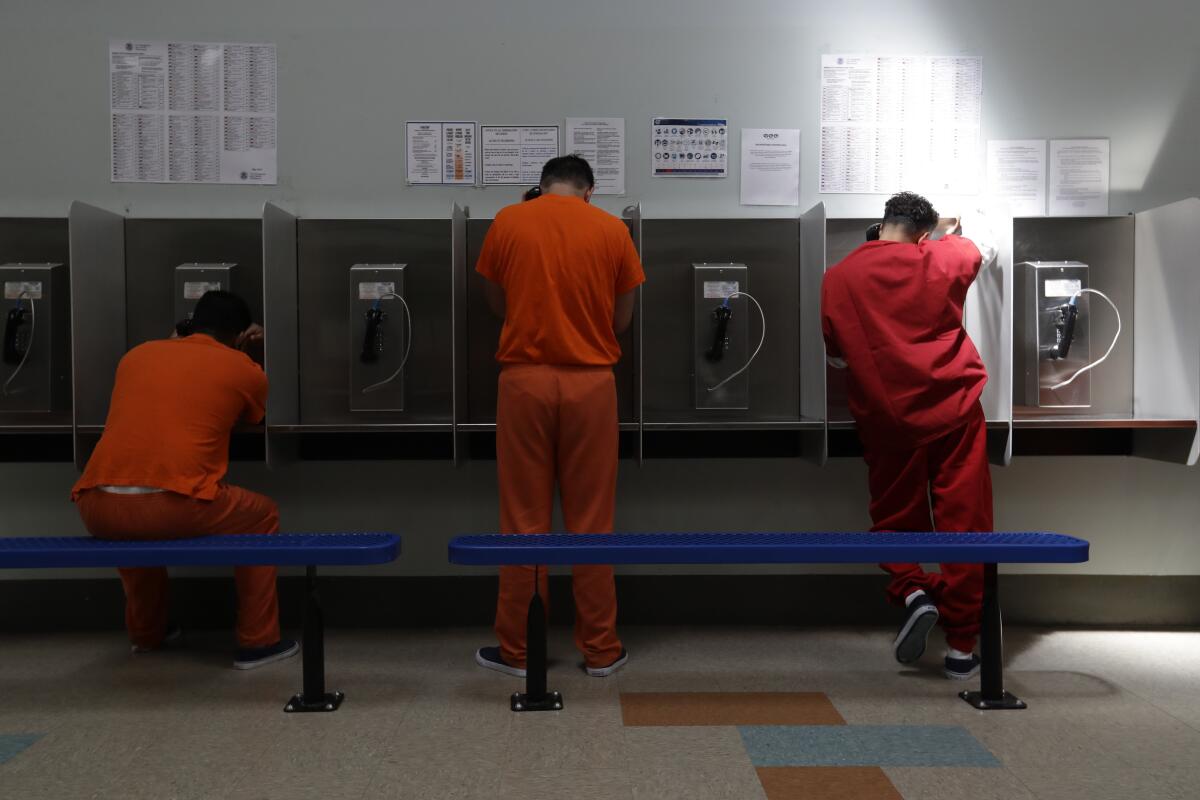California doctors analyzed detained migrants’ medical emergencies. Here’s what they found

- Share via
WASHINGTON, D.C. — An investigation published Wednesday in the Journal of the American Medical Assn. found discrepancies between emergencies at California immigrant detention facilities that were reported to local authorities and those reported publicly by the federal government.
The study, led by Dr. Annette Dekker, an assistant professor of emergency medicine at UCLA, analyzed about 1,200 emergencies from 2018 through 2022 at three detention centers: the Adelanto ICE Processing Center in San Bernardino County, the Otay Mesa Detention Center in San Diego and the Imperial Regional Detention Facility east of San Diego. Most of the patients involved were men, and the median age was 39. Local authorities responsible for emergencies at two other facilities in California did not provide data.
Private prison companies manage seven immigrant detention facilities in California on behalf of U.S. Immigration and Customs Enforcement, with space to detain more than 7,000 people.
Psychiatric emergencies made up just 48 of the EMS responses reviewed by Dekker and four other California doctors — less than 4% — despite significantly higher rates of such complaints reported by ICE during the same period.
At each facility, the number of psychiatric emergencies reported to EMS was fewer than or equal to the number of suicide attempts reported by ICE. When other ICE-reported mental health issues that required observation were added to that total, Dekker said, there was a tenfold increase over the total reported by local EMS agencies.
Dekker said she believes that discrepancy could be interpreted to mean that all but the most extreme psychiatric crises are being appropriately treated by in-house medical staff. A 2021 California Department of Justice inspection review highlighted significant mental healthcare deficiencies at all three facilities, including understaffing and care delays.
“It’s possible someone has a suicide attempt that doesn’t require EMS, but speaking as an emergency physician, there are a lot of different psychiatric emergencies — some related to [suicidal] ideation, some related to psychosis — so it is odd to me that the number of EMS-reported psychiatric emergencies isn’t higher,” Dekker said. “Why aren’t the medical staff reaching out for more help?”
Medical reviews aren’t required unless a detainee dies in ICE custody, the report notes.
“Systematic substandard care has been identified as a factor associated with these deaths, including a lack of recognition of severe illness, medical staff dismissal of concerns about individuals’ health, and delays in activating external emergency care,” the report states. “These findings suggest that there are near misses not captured in death reviews.”
ICE spokesperson Alethea Smock did not respond to questions about the report. Smock said comprehensive medical care is provided throughout the time that people are detained, including an intake screening within 12 hours of arrival, a full health assessment within two weeks and access to medical appointments and 24-hour emergency care.
“At no time during detention is a noncitizen denied emergency care,” Smock said.
Documents offer a rare look into one of several known instances in which ICE detainees were discharged as they were on the edge of death.
Detainees cannot access 911 and must rely on staff to call on their behalf. Broadly, death reviews show that some responses to requests for help have been delayed.
At the Adelanto and Imperial facilities, the rates of EMS-reported emergencies were lower for women than men. But at Otay Mesa, the rate was significantly higher for women, including 12% of emergencies related to pregnancy concerns.
An ICE directive issued on July 1, 2021, says “ICE should not detain” people who are pregnant, postpartum or nursing and should ensure their expeditious release from custody. Seven EMS-reported emergencies for pregnancy-related concerns were recorded after the directive took effect, “indicating that Otay Mesa continued to house pregnant individuals despite ICE directives,” the report notes.
Authors of the JAMA report said it is unclear whether the higher rate of emergencies among female patients at Otay Mesa represents higher rates of illness or better detainee health monitoring. But the 2021 California Department of Justice inspection noted that all three facilities “impermissibly house female detainees in restrictive housing under conditions disparate to those of male detainees.”
More than a quarter of patients at all three facilities had at least one abnormal vital sign reading during their encounter with medics — most frequently an elevated heart rate. Among all three facilities, the top three primary symptoms reported by patients were chest pain, abdominal pain and altered mental status. Traumatic injury was also among the issues most frequently reported by EMS providers.
The rate of emergencies at all three facilities increased amid the pandemic despite efforts to reduce capacity at the facilities during that time.
Between January 2019 and December 2021, there were 742 EMS-reported emergencies. During the same period, ICE reported 1,481 medical emergencies. Dekker said the discrepancy suggests that EMS data fail to capture the total number of medical emergencies occurring in ICE facilities.
Unlike ICE, publicly funded healthcare systems such as Medicare and Medicaid have greater government oversight that requires them to report more rigorous metrics, Dekker said. She said recent ICE facility reports contain less data than in years past and no longer include metrics such as off-site medical emergencies and the number of suicide attempts.
“I have walked away with significantly more questions than when I started,” Dekker said of the report. “The bottom line is that we need expanded reporting from ICE on health outcomes to understand what’s going on.”
More to Read
Get the L.A. Times Politics newsletter
Deeply reported insights into legislation, politics and policy from Sacramento, Washington and beyond. In your inbox twice per week.
You may occasionally receive promotional content from the Los Angeles Times.









